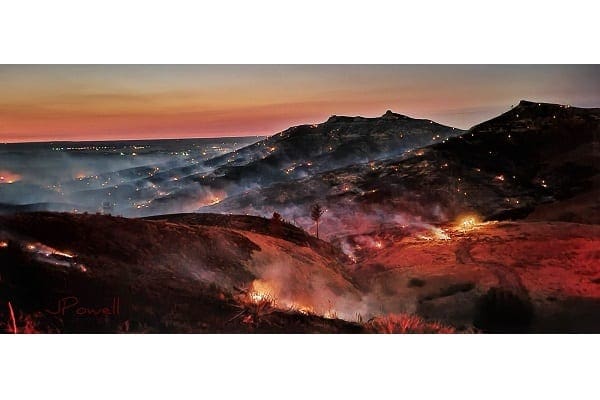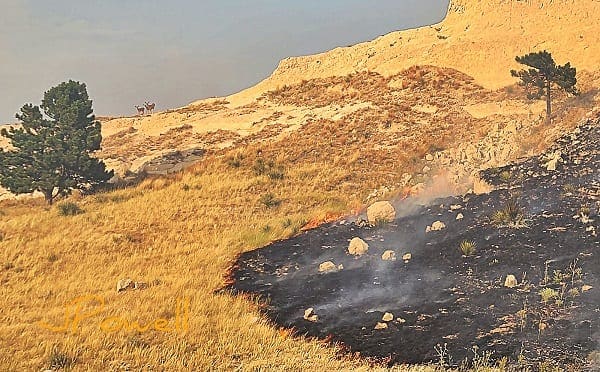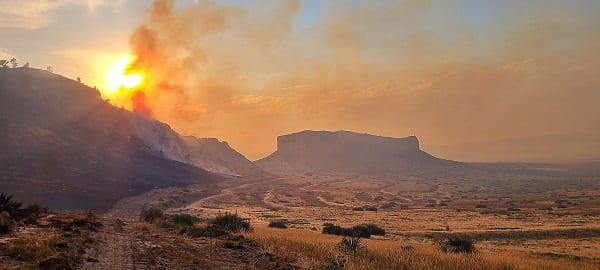Wildlife officials observing effects from wildfires

McGREW, Neb. – Wildlife managers in the Nebraska Panhandle say the full effects of the region’s wildfires during the final days of August largely will be determined by what Mother Nature does in coming weeks and months.
The public land most affected was Williams Gap Wildlife Management Area in Banner County. Along with 2,900 acres of adjacent private land, the fire burned about 1,100 acres on the 1,829-acre wildlife area. During the same period, some U.S. Forest Service property 3 miles south of Chadron was burned in the 400-acre Aristocrat Fire.
Acquired by Nebraska Game and Parks Commission, and opened in 2015, Williams Gap features the steep sandstone cliffs of Sheep Mountain and other landforms, making it popular with bighorn sheep. The fire burned many of the trees on the property. How many will survive will not be known until later, said wildlife biologist Chris Becker of Scottsbluff.
Biologists say the amount of precipitation in coming weeks will affect how wildlife populations respond to burn areas this year.
“Overall wildfires have both good and bad long-term effects and how much of each will depend on when we start getting rain,” Becker said of the Hubbard’s Gap fire. “It will likely make the area better bighorn sheep habitat with the reduction of woody vegetation.”
However, it could have negative effects on deer and turkey hunting this year if there is not much green-up, he added.
“Much of the upland bird-small game habitat was burned and won’t provide much hunting opportunity this season,” he said.

Rick Arnold, a biologist based at Ponderosa Field Office near Crawford, responded to both fires and observed wildlife as they escaped the scene. A ewe and a lamb bighorn sheep were found dead after the Hubbard’s Gap burn, but no other significant wildlife losses were observed.
“We saw some really nice mule deer bucks in that rough country behind the college on Forest Service,” Arnold said, in reference to the fire near Chadron. “With any rain, those deer will be right back on the fall green-up forages.”
Wildlife biologist Justin Powell of Alliance said fire is not all bad. He said some animals may be driven off the burned areas, but some may be attracted to it.
“The Aristocrat fire was a pretty beneficial burn. Besides losing some of the regeneration trees, it did a great job of cleaning up old deadfall from the ’06 fire in the same location,” he said. “In general, fires can be super beneficial to a hunter. In fact, in states like Colorado, a good way to find elk is to target burn areas. No exception here —fresh green vegetation, less cover for predators, and easily available grit and insects — all a draw for game animals.”
More than a half-dozen Game and Parks employees joined the many volunteer fire departments and other responders on the fires. In addition to loss of trees, boundary fence posts and signs at Williams Gap will need to be replaced.
Even though it has been dry this summer, Becker said the fuels at Williams Gap had been reduced by grazing cattle and was somewhat surprised the fire was able to move over the property as quickly as it did. The tenants moved cattle from the property just before the fire arrived.

Wildfires have raged throughout the western United States this summer. Nebraska officials are hopeful that no catastrophic wildfires start this fall, but with much of the region suffering from a drought the risk still remains high. They encourage people to use extreme caution with outdoor activities.
While lightning has been identified as the cause of the fire near Chadron, officials suspect human activity may be to blame for the Hubbard’s Gap fire. It is still under investigation.

